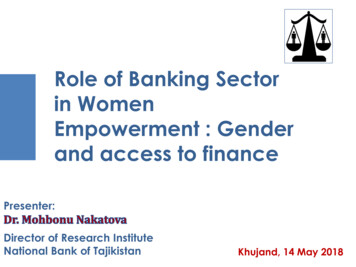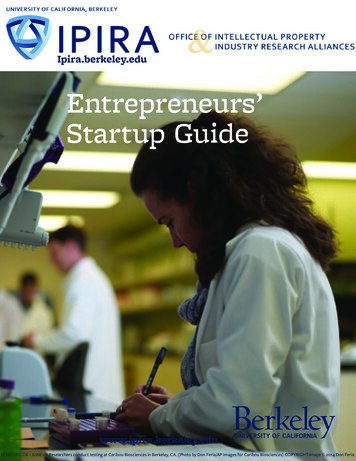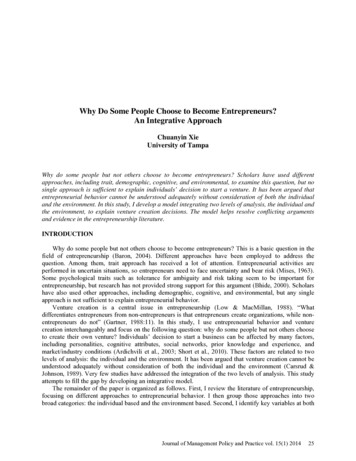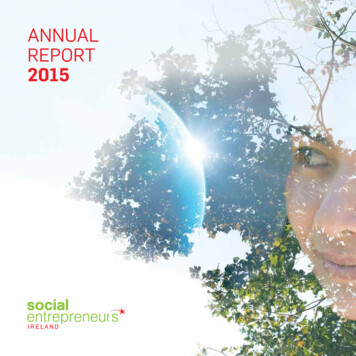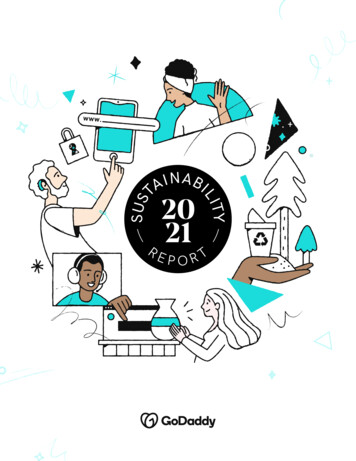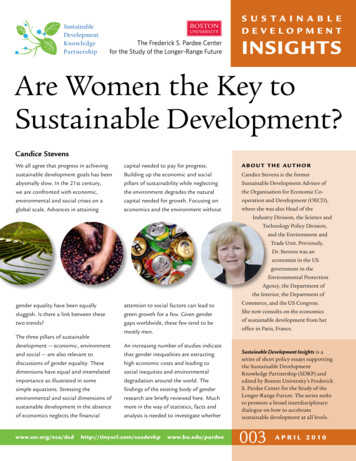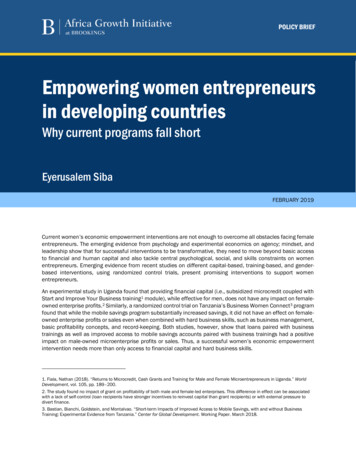
Transcription
POLICY BRIEFEmpowering women entrepreneursin developing countriesWhy current programs fall shortEyerusalem SibaFEBRUARY 2019Current women’s economic empowerment interventions are not enough to overcome all obstacles facing femaleentrepreneurs. The emerging evidence from psychology and experimental economics on agency; mindset, andleadership show that for successful interventions to be transformative, they need to move beyond basic accessto financial and human capital and also tackle central psychological, social, and skills constraints on womenentrepreneurs. Emerging evidence from recent studies on different capital-based, training-based, and genderbased interventions, using randomized control trials, present promising interventions to support womenentrepreneurs.An experimental study in Uganda found that providing financial capital (i.e., subsidized microcredit coupled withStart and Improve Your Business training1 module), while effective for men, does not have any impact on femaleowned enterprise profits.2 Similarly, a randomized control trial on Tanzania’s Business Women Connect 3 programfound that while the mobile savings program substantially increased savings, it did not have an effect on femaleowned enterprise profits or sales even when combined with hard business skills, such as business management,basic profitability concepts, and record-keeping. Both studies, however, show that loans paired with businesstrainings as well as improved access to mobile savings accounts paired with business trainings had a positiveimpact on male-owned microenterprise profits or sales. Thus, a successful women’s economic empowermentintervention needs more than only access to financial capital and hard business skills.1. Fiala, Nathan (2018). “Returns to Microcredit, Cash Grants and Training for Male and Female Microentrepreneurs in Uganda.” WorldDevelopment, vol. 105, pp. 189–200.2. The study found no impact of grant on profitability of both male and female-led enterprises. This difference in effect can be associatedwith a lack of self-control (loan recipients have stronger incentives to reinvest capital than grant recipients) or with external pressure todivert finance.3. Bastian, Bianchi, Goldstein, and Montalvao. “Short-term Impacts of Improved Access to Mobile Savings, with and without BusinessTraining: Experimental Evidence from Tanzania.” Center for Global Development. Working Paper. March 2018.
Empowering women entrepreneurs in developing countriesAFRICA GROWTH INITIATIVEOn the other hand, a randomized field experiment on Nicaragua’s Small Business of the Family Economy 4program found that business trainings significantly increased self-employed men and women’s real income—with a higher impact for women. This impact could be due to the nature of the training’s program itself; theprogram not only provided production techniques, business organization, and administrative skills but also hadtalks about creation of business plan, networking, establishment of virtual stores, and access to new marketscomponents.5More importantly, men and women entrepreneurs face inherently different constraints including psychologicaland cultural factors. Female entrepreneurs are often lacking in access to financial and human capital, 6 whichimpedes business growth, have different mindset constraints, such as risk-aversion, and have not caught up insoft skills such as leadership. In addition, women have culturally imposed-constraints that psychologically andphysically impede their independence, aspiration, and priorities. Thus, the success of female entrepreneursdepends on their personal traits and entrepreneurial skills, and how supportive institutions and stakeholdersaddress or work around these major constraints.To truly empower women, policymakers needs to address these constraints. As Andrea Cornwall 7—a leadinganthropologist from the University of Sussex—proposes two elements of change: first, consciousness needs tobe shifted—overturning internalized constraints and aspirational barriers that keep women in situations ofsubordination—and second, cultural beliefs about gender and power must be challenged.SHIFT IN CONSCIOUSNESS AND MINDSETIn comparison to men, many disadvantaged female micro-entrepreneurs suffer from mindset constraints. Forinstance, a study on Tanzania’s PRIDE training program 8 shows that women are more risk-averse than men are.A lab experiment, after financial capital and basic business training intervention, found that women still engagein fewer competitive scenarios than men do. This type of mindset inhibits profits and overall improvement ofbusiness performance. The lab experiment looking at mindset constraints found that, with the same intervention(which taught soft skills around entrepreneurial characters such as long-term view and orientation in business,self-confidence, and managing people), men, not constrained in this way, saw a significant increase in sales.Some business training programs, specifically set out to shift mindsets, found a positive impact on femaleentrepreneurs. For instance, a personal initiative-training program in Togo,9 run by World Bank’s GenderInnovation Lab, offered psychology based “mindset” training for both male and female business owners. Thesoft skills included self-starting behaviors, innovation, identifying and exploiting new opportunities, goal setting,planning, and feedback cycles, and overcoming obstacles. The training program found business performanceimprovements for both male and female enterprises, and interestingly, the main effect of the training on womenseemed to be an increase in women’s personal initiative. In addition, the effect on women’s soft skills posttraining held constant regardless of education level10 (with slight differentiations along training background).4. Kim, Rodriguez-Ramirez, and Yang. “Does the Small Business Program Benefit Self-Employed Workers? Evidence from Nicaragua.” KDISchool of Public Policy and Management. 2018.5. It could also be due to the nature of the experiment itself. The program targeted mostly low-educated self-employed workers, while theUganda and the Tanzania training programs targeted a greater variety of backgrounds (lower educated entrepreneurs show a highermarginal return from trainings than better educated entrepreneurs). Other considerations when comparing different studies include: costeffectiveness over longer period; general equilibrium effect and/or placebo effect, and other data and publication considerations.6. Adoho, Chakravarty, Korkoyah, Lundberg, and Tasneem. “The Impact of an Adolescent Girls Employment Program – The EPAG Project inLiberia.” World Bank Africa Region Poverty & Reduction Management Unit & Human Development Network Social Protection and LaborUnit. April 2014.7. Cornwall, Andrea. “Women’s Empowerment: What Works?” Journal of International Development. Volume 28, Issue 3. March 28, 2016.8. Berge, Lars Ivar Oppedal, Kjetil Bjorvatn, Bertil Tungodden. “Human and Financial Capital for Microenterprise Development: Evidencefrom a Field and Lab Experiment.” SSRN Electronic Journal, doi:10.2139/ssrn.1750026. 2011.9. Campos, Frese, Goldstein, Iacovone, Johnson, McKenzie, Mensmann. “Teaching personal initiative beats traditional training in boostingsmall business in West Africa,” Science, Vol. 357, Issue 6357, pp. 1287-1290.10. Campos, Frese, Goldstein, Iacovone, Johnson, McKenzie, Mensmann. “Is Personal Initiative Training a Substitute or Complement to theExisting Human Capital of Women? Results from a Randomized Trial in Togo.” American Economic Association. Pp. 256-261. May 2018.2
Empowering women entrepreneurs in developing countriesAFRICA GROWTH INITIATIVELabor market studies also find that mindset interventions prove effective , by either instilling aspirations orshifting perceptions of labor market opportunities (whether in formal employment or self-employment). A studyin Ethiopia11 showed that an hour video to rural farmers showing successful peers was effective in shifting futureoriented behaviors. Another study in India12 that provided information to rural women on job opportunities forthem in the outsourcing industry, led to more education, lower desired fertility, and higher likelihood of enteringthe job marketCHALLENGING GENDER IDENTITIESAnother pivotal component to any intervention seeking to make a transformative change is challenging genderidentity roles. In Tanzania’s PRIDE study cited above, for instance, women report to spend on average 10 hoursless in their businesses per week than men. The component of owner’s time is a critically binding constraint,notably for enterprises with fewer employees.13 Women also report to have lesser say in important householdand business decisions and divert business resources to household expenditures, due to either externalpressures14 or lack of self-control.15 A randomized control trial experiment in Kenya found that expanding accessto savings accounts increased the probability of saving for self-employed women working as market vendors,and increased their productive investment and private expenditures, implying significant barriers to savings andinvestment.16 Another gender component inhibiting women is crowding out effect, meaning women are stoppedfrom expanding their businesses because capital grant led to a reduction of external financial support from theirspouses. 17Business training interventions emphasizing the need to challenge or work around gender identities, in additionto soft skills and shifting mindsets, have found a small but positive shift in perspective. Liberia’s EconomicEmpowerment of Adolescent Girls training program 18 included hard and technical skills such as office computerskills and accommodated the special needs of female entrepreneurs—safe locations and free childcare. Studiedthrough a randomized control trial, the training program was found to increase earnings of female entrepreneursand positively affect female self-confidence and self-assessed entrepreneurial ability. The most significantfinding is the program saw a small but positive shift in self-reported gender role perspective—meaning surveyrespondents were more likely to report that both men and women should take care of household responsibilities.TEACHING LIFE SKILLS AND PROVIDING TECHNOLOGY SOLUTIONSTrainings that go beyond financial capital and basic business skills, and teach necessary life skills have alsoshown a small, but positive impact on female-owned microenterprises. For instance, a Peruvian training program11. Adoho, Chakravarty, Korkoyah, Lundberg, and Tasneem. “The Impact of an Adolescent Girls Employment Program – The EPAG Projectin Liberia.” World Bank Africa Region Poverty & Reduction Management Unit & Human Development Network Social Protection and LaborUnit. April 2014.12. Robert Jensen (2012), “Do Labour Market Opportunities Affect Young Women's Work and Family Decisions? Experimental Evidencefrom India,” The Quarterly Journal of Economics, Volume 127, Issue 2, pp. 753–792. May 1, 2012.13. Eyerusalem Siba (2015), “Returns to Physical Capital in Ethiopia: Comparative Analysis of Formal and Informal Firms,” WorldDevelopment, Volume 68, pp. 215-229. April 2015.14. De Mel (2009), “Are Women More Credit Constrained? Experimental Evidence on Gender and Microenterprise Returns.” January 11,2009.15. Fafchamps, Marcel; McKenzie, David; Quinn, Simon; Woodruff, Christopher. 2011. When is capital enough to get female enterprisesgrowing? Evidence from a randomized experiment in Ghana (English). Policy Research working paper; no. WPS 5706. Washington, DC:World Bank.16. Pascaline Dupas and Jonathan Robinson (2013), Savings Constraints and Microenterprise Development: Evidence from a FieldExperiment in Kenya, American Economic Journal: Applied Economics 2013, 5(1): 163–19217. Berge, Lars Ivar Oppedal, Kjetil Bjorvatn, Bertil Tungodden. “Human and Financial Capital for Microenterprise Development: Evidencefrom a Field and Lab Experiment.” SSRN Electronic Journal, 2011, doi:10.2139/ssrn.1750026.18. Adoho, Chakravarty, Korkoyah, Lundberg, and Tasneem. “The Impact of an Adolescent Girls Employment Program – The EPAG Projectin Liberia.” World Bank Africa Region Poverty & Reduction Management Unit & Human Development Network Social Protection and LaborUnit. April 2014.3
Empowering women entrepreneurs in developing countriesAFRICA GROWTH INITIATIVEprovided to clients of FINCA-Peru,19 a micro finance institution, taught general business skills such as how tocalculate production costs and product pricing in addition to life skills such as separating business and homefinances. The result—found through randomized control trials—was a positive, albeit small, impact of the Peruviantraining program on female-led enterprise revenues.Similarly, a randomized control trial on Tanzania’s Business Women Connect program, cited above, found thatwomen save substantially more through a mobile savings account. The same study found that providing womenwith a business skills training bolstered the effect. Higher proportion of married women who participated in themobile savings program reported that they were the sole decision makers about their own personal expendituresthan those who did not participate in the program. Thus, the mobile savings program has had unexpectedempowerment outcomes for women, though it did not influence female-owned enterprise profits or sales.To summarize, successful interventions, among studies reviewed above, have usually paired basic businessskills provision (as we all as basic financial capital) with provision of soft skills such as leadership and mindsetconsiderations. Moreover, programs that address or work around socially imposed gender roles increase femaleunderstanding of inhibiting normative assumptions.19. Karlan, Dean, and Martin Valdivia. “Teaching Entrepreneurship: Impact of Business Training on Microfinance Clients and Institutions.”Review of Economics and Statistics, vol. 93, no. 2, pp. 510–527. 2011.4
Empowering women entrepreneurs in developing countriesAFRICA GROWTH INITIATIVEIMPLICATIONS FOR POLICY AND PRACTICEI.Providing business skills trainings is a basic step toward empowering women entrepreneurs, but to trulyachieve transformative change, training programs need to address deeper psychological and socialconstraints facing women. In practice, though, skill-centric interventions are hard to get right—they havehigh dropout rates, are less cost-effective compared to capital focused programs (grants and assets inparticular, though not microcredits), and often need to be complemented by capital injection.20 Three ofthe common traits of successful skills interventions include demand driven (i.e., provided skills that aremissing and binding to enterprise performance), market-centric (i.e., provided trainings which taughtidentifying new market opportunities or addressed existing market failures)21, and consideration of theentrepreneur (i.e., gender lens) to leverage strength and address specific constraints.II.Similarly, financial access, while a basic step in women’s economic empowerment, cannot alone helpgrow subsistence enterprises owned by woman who face multiple binding constraints.22 While advancesin technology, in-kind grants, and life skills training programs assist female entrepreneurs in keeping theirprofessional and personal savings accounts safe and separate, and address key saving and investmentconstraints, there is a widespread concern about microcredits. Notably, the type and the institutionalarrangements of the loan (i.e., size, tenor, terms, and type of financial institution) define the success, costeffectiveness, and attractiveness of microcredits. The conversation needs to shift toward making creditmarkets work better for women.III.Finally, a clear measure of success is important. Provision of basic technical business training programs,at best, improved business practice of women-owned enterprises, often without any significant progressin business performance or empowerment more broadly. While some interventions have improved botheconomic and subjective welling of female entrepreneurs, it is generally hard to grow employment inSMEs.23 Conventional micro-interventions providing access to credit and business training for the poorhave also proven ineffective in bringing major changes in women’s economic empowerment. 24 Sustainingwomen’s empowerment hinges on the longevity and effectiveness of program interventions and oncontinuous policy commitment to inclusion and equality.20. Blattman, Christopher and Ralston, Laura, Generating Employment in Poor and Fragile States: Evidence from Labor Market andEntrepreneurship Programs (July 19, 2015); Yoonyoung Cho and Maddelena Honorati (2014) “Entrepreneurship programs in developingcountries: A meta regression analysis,” Labour Economics, Volume 28, Pp. 110-130. June 2014.21. McKenzie, David J., “How effective are active labor market policies in developing countries? a critical review of recent evidence”(English). Policy Research working paper; no. WPS 8011; Impact Evaluation series. Washington, D.C.: World Bank Group. 2017; Kim,Rodriguez-Ramirez, and Yang. “Does the Small Business Program Benefit Self-Employed Workers? Evidence from Nicaragua.” KDI Schoolof Public Policy and Management. 2018.22. Fafchamps, Marcel; McKenzie, David; Quinn, Simon; Woodruff, Christopher. 2011. “When is capital enough to get female enterprisesgrowing? Evidence from a randomized experiment in Ghana” (English). Policy Research working paper; no. WPS 5706. Washington, DC:World Bank.23. Michael Grimm and Anna Luisa Paffhausen (2014), “Do Interventions Targeted at Micro-Entrepreneurs and Small and Medium-SizedFirms Create Jobs? A Systematic Review of the Evidence for Low and Middle Income Countries,” IZA DP No. 8193. May 2014.24. Esther Duflo (2012) “Women Empowerment and Economic Development,” Journal of Economic Literature, 50(4), 1051–1079. 2012.5
Empowering women entrepreneurs in developing countriesAFRICA GROWTH INITIATIVEAPPENDIXTable 1: Select studies on different capital-based, training-based, and gender-based interventionsNameDescriptionSkills TaughtDurationOther Services?FindingsSmall Businessof the FamilyEconomy25In Nicaragua, for both men and women.1. Creation of business plans.2. Business organization3. Networking and access to newmarkets4. Administrative and productivetechniques100 hours oftraining for threemonths &strengtheningtalks that areconducted in oneday for 4 hours.12 2.5 hourtraining sessions;face-to-face plusthe mobiletraining modules.No.Three months.Coupled witheither grant orloan.Increased real income of women and men,with slightly lower effect on men. All in all,the findings suggest that females are likelyto benefit from a program that enablesthem to create their own businesses andimprove their productive andadministrative techniques.Six-months post-intervention women savesubstantially more, and business traininghelps bolster effect. Business training alsoled to an improvement in the businesspractices of women. We find no significantevidence that these impacts translate intogreater investment, sales, and profits, butwe see evidence of increased businessexpansion through the creation ofprofitable secondary business as well asimprovements in women’s empowermentand subjective well-being.Significant positive results for effect ofloans on male-led businesses but not forwomen. No effect from cash grants foreither men or women because both groupsused the money for short-termconsumption needs rather thaninvestment. Thus, it is likely that therequirement for repayment induced menuse the money for investment.Year: 2018.Goal: To promote SMEs and their growth.BusinessWomenConnect26Dependent variable: self-employed workers’ income.In Tanzania.Year: 2018.Target: Only female micro entrepreneurs.Goal: To improve the business performance of womenmicro entrepreneurs, designed by Techno Serve, byproviding them with improved access to savings throughmobile money and business trainingStart andImprove YourBusiness27In Uganda.Year: 2018.Target: Male and low-income female business ownerswho expressed interest in receiving trainings and loans.The businesses under study did not typically fit thelending requirements of the MFI. A loan guarantee wasprovided by ILO to mitigate risk.1. Business expansion andprofitability2. Finance and record-keeping3. Entrepreneurship and businessplanning4. Personal and professionalefficacy.“Good business practices” thatenables existing entrepreneurs todevelop their skills andimprovement plans in buying,stock control, marketing, costing,record keeping, business planningand human resourcesmanagement, and Enables growthorientedCoupled withaccess to mobilesavings.Goal: To enhance business performance throughsubsidized loan, grant and free business skills training.2825. Kim, Rodriguez-Ramirez, and Yang. “Does the Small Business Program Benefit Self-Employed Workers? Evidence from Nicaragua.” KDI School of Public Policy and Management. 2018.26. Bastian, Bianchi, Goldstein, and Montalvao. “Short-term Impacts of Improved Access to Mobile Savings, with and without Business Training: Experimental Evidence from Tanzania.” Center for GlobalDevelopment. Working Paper. March 2018.27. Fiala, Nathan. “Returns to Microcredit, Cash Grants and Training for Male and Female Micro-entrepreneurs in Uganda.” World Development, vol. 105, 2018, pp. 189–200.28. ILO provides the Start and Improve Your Business training program with a focus on starting and improving businesses for women and men in at least 100 countries. The training has four packages thatresponds to stages of business development. The packages include: 1) Generate Your Business Idea: to enables potential entrepreneurs to develop a concrete business idea; 2) Start Your Business: to6
Empowering women entrepreneurs in developing countriesPRIDE (MFI)29Randomized field experiments in Tanzania.Year: 2012.Target: small scale male and female entrepreneursGoal: Unleashing entrepreneurship & creating businessgrowth.FINCA31Randomized control trial in Peruvian village bankingprogram for poor female entrepreneurs with little formaleducation.Target: Female micro entrepreneurs who are FINCAPeru, MFI, clients.AFRICA GROWTH INITIATIVE1. Entrepreneurship andentrepreneurial character.2. Improving customer service.3. Managing people in yourbusiness.4. Marketing strategiesWeekly basis,from Aug. 2008Jan. 2009. 21sessions eachlasting 45minutes.Coupled withfinancial capitalSix monthsCoupled withmicrofinanceservices.Note: Skills were often illustratedwith case studies1. Savings methods2. General business skills andstrategy3. Separating business and homefinances4. Calculating production costs andproduct pricing.Goal: To buildthe human capital of micro entrepreneurs in order toimprove the livelihoodof the MFI clients and help further MFI’s mission ofpoverty alleviationSubstantial improvement for maleentrepreneurs (i.e., increase in sales of 2530 percent), but not for femaleentrepreneurs (training has not empoweredfemales), citing differences in effect oftraining could be due to mindset30, externalconstraints, and crowding out effects.There is, however, positive effect oftrainings on both female and malebusiness knowledge. Better businesspractices among both males and females.Training programs themselves with a DIDanalysis find a positive but small impact oftrainings on enterprise revenues. Clientsalso reported greater engagement in theactivities taught by the training program.But, it did not have an impact onregistration for formal business licenses,did not increase the number of saleslocations, and did not induceentrepreneurs to keep records to paymentsof workers, start a new business, orincrease the number of businesses thatreported planning innovations.enable potential entrepreneurs with a business idea to develop a bankable business plan; 3). Improve Your Business: to enable existing entrepreneurs to develop their skills and improvement plans in buying,stock control, marketing, costing, record keeping, business planning and human resources management, and 4) Expand Your Business: to enable growth-oriented.29. Berge et al. MFI providing the trainings Berge, Lars Ivar Oppedal, Kjetil Bjorvatn, Bertil Tungodden. “Human and Financial Capital for Microenterprise Development: Evidence from a Field and LabExperiment.” SSRN Electronic Journal, doi:10.2139/ssrn.1750026. 2011.30. Mindset determinants as well as having self-confidence were included in the entrepreneurial character the training sought to implement. Mindset also refers to having a long-term view and orientation inthe business. These mindset determinants were studied in a lab context.31. Karlan, Dean, and Martin Valdivia. “Teaching Entrepreneurship: Impact of Business Training on Microfinance Clients and Institutions.” Review of Economics and Statistics, vol. 93, no. 2, pp. 510–527.2011.7
Empowering women entrepreneurs in developing countriesEconomicEmpowermentof AdolescentGirls32AFRICA GROWTH INITIATIVERandomized control trial. Part of a larger initiativeadministered by World Bank.Assigned to a Job Skills track or aBusiness Development track.Target: women of age 16-27, possessing basic literacyand numeracy skills, not enrolled in school for severalmonths prior to program initiation.Job skills:1. Hospitality,2. Professional cleaning3. Office/computer skills4. Professional house/officepainting5. Security guard service.6. Professional driving.Goal: Increasing the employment and income of 2500young Liberian women by providing livelihood and lifeskills training and facilitating their transition toproductive work.Six months ofclassroom-basedtrainings followedby six months ofjob placementsupport for eitherself or wageemploymentBusiness Development:1. Identify micro-enterpriseopportunities based on anassessment of market needs2. How to grow and 33Training program in Togo financed by the World Bank.Target: 789 female-owned microenterprises. Theaverage owner is 42.7 years old, has 7 years ofschooling, and has been running her firm for a mean of13.6 years.1. Mindset of self-startingbehaviors, innovation, identifyingand exploring new opportunities2. Goal-setting, planning, andfeedback cycle3. Overcoming obstacles.Goal: To develop key behaviors associated with aproactive entrepreneurial mindset12 three-hoursessions taughtthree times aweek in April2014, followed bya trainer visitingthe business forthe next fourmonths.Performancesbonuses wereawarded totraining providersthat successfullyplace theirgraduates in jobs,contests andcompetitionswere held.Programdesigned aroundgirls’ needs: heldboth morning andafternoonsessions, toaccommodateparticipants’ busyschedules, everysite offered freechildcare.No.Program’s business skills track had higherimpacts on employment and earnings thanthe job skills track, which focused on wageemployment. Improvement in a wide rangeof subjective outcomes including: worry, lifesatisfaction, self-regulation, selfconfidence, and self-perceptions of socialabilities. Household shift in gender normsperspective: respondents were asked i.e.who should be responsible for a series offive household tasks.Personal initiative training increasedbusiness sales and business profits forwomen (although not statisticallysignificant). These treatment effects aredifferent from training that only focuses onhard skills (also studied in this paper).Finds that the training program issuccessful for those with all levels ofschooling and does not show significantchanges with a range of human capitalmeasures.32. Adoho, Chakravarty, Korkoyah, Lundberg, and Tasneem. “The Impact of an Adolescent Girls Employment Program – The EPAG Project in Liberia.” World Bank Africa Region Poverty & ReductionManagement Unit & Human Development Network Social Protection and Labor Unit. April 2014.33. Campos, Frese, Goldstein, Iacovone, Johnson, McKenzie, Mensmann. “Is Personal Initiative Training a Substitute or Complement to the Existing Human Capital of Women? Results from a RandomizedTrial in Togo.” American Economic Association. Pp. 256-61. May 2018.8
Empowering women entrepreneurs in developing countriesAFRICA GROWTH INITIATIVEAuthor’s NoteThe author is grateful for feedback from Jeremy Barofsky; Christina Kwauk, Carol Newman; John Page; JohnRand, Aly Salman and Conference Participants of UNU-WIDER’s Think Development 2018 conference heldin Helsinki, Finland. Eyerusalem is also grateful to Kiara Rodriguez Gallego, a Princeton Internship in CivicService fellow, for excellent research assistance and Joshua Miller for editorial support.AcknowledgementThe Brookings Institution is a nonprofit organization devoted to independent research and policy solutions.Its mission is to conduct high-quality, independent research and, based on that research, to provideinnovative, practical recommendations for policymakers and the public. The conclusions andrecommendations of any Brookings publication are solely those of its author(s), and do not reflect the viewsof the Institution, its management, or its other scholars.Brookings recognizes that the value it provides is in its absolute commitment to quality, independence andimpact. Activities supported by its donors reflect this commitment and the analysis and recommendationsare not determined or influenced by any donation. A full list of contributors to the Brookings Institution canbe found in the Annual Report at 9
talks about creation of business plan, networking, establishment of virtual stores, and access to new markets components. 5 More importantly, men and women entrepreneurs face inherently different .
